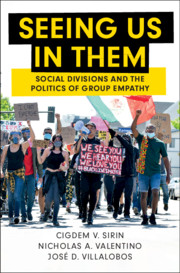Book contents
- Seeing Us in Them
- Cambridge Studies in Public Opinion and Political Psychology
- Seeing Us in Them
- Copyright page
- Dedication
- Contents
- Figures
- Tables
- Prologue
- 1 The Puzzle
- 2 Group Empathy Theory
- 3 Measuring Group Empathy
- 4 An Origin Story
- 5 Group Empathy and Homeland Security
- 6 Group Empathy and the Politics of Immigration
- 7 Group Empathy and Foreign Policy
- 8 Group Empathy in the Era of Trump
- 9 Group Empathy, Brexit, and Public Opinion in the United Kingdom
- 10 Cultivating Group Empathy and Challenging Ethnonationalist Politics
- Epilogue Group Empathy in Response to the COVID-19 Pandemic
- References
- Index
- Books in the series
2 - Group Empathy Theory
Published online by Cambridge University Press: 11 March 2021
- Seeing Us in Them
- Cambridge Studies in Public Opinion and Political Psychology
- Seeing Us in Them
- Copyright page
- Dedication
- Contents
- Figures
- Tables
- Prologue
- 1 The Puzzle
- 2 Group Empathy Theory
- 3 Measuring Group Empathy
- 4 An Origin Story
- 5 Group Empathy and Homeland Security
- 6 Group Empathy and the Politics of Immigration
- 7 Group Empathy and Foreign Policy
- 8 Group Empathy in the Era of Trump
- 9 Group Empathy, Brexit, and Public Opinion in the United Kingdom
- 10 Cultivating Group Empathy and Challenging Ethnonationalist Politics
- Epilogue Group Empathy in Response to the COVID-19 Pandemic
- References
- Index
- Books in the series
Summary
Chapter 2 introduces Group Empathy Theory. We define empathy as the ability to take the perspective of others and experience their emotions, combined with the motivation to care about their welfare. Outgroup empathy arises when this combination of skill and motivation is directed toward social collectives with whom one has little in common. We expect intergroup empathy to differ from interpersonal empathy and to more powerfully explain political attitudes and behavior. The theory further predicts racial/ethnic differences in group empathy due to variations in socialization patterns and life experiences (such as discrimination). Chapter 2 also discusses how Group Empathy Theory challenges one of the key tenets of Social Identity Theory (SIT) concerning ingroup favoritism and outgroup discrimination. We argue that minorities who identify more strongly with their ingroup will display higher empathy for outgroups – a prediction counterintuitive to SIT. In short, Chapter 2 lays the groundwork for unique theoretical expectations we then test in the subsequent chapters.
Keywords
- Type
- Chapter
- Information
- Seeing Us in ThemSocial Divisions and the Politics of Group Empathy, pp. 20 - 39Publisher: Cambridge University PressPrint publication year: 2021

